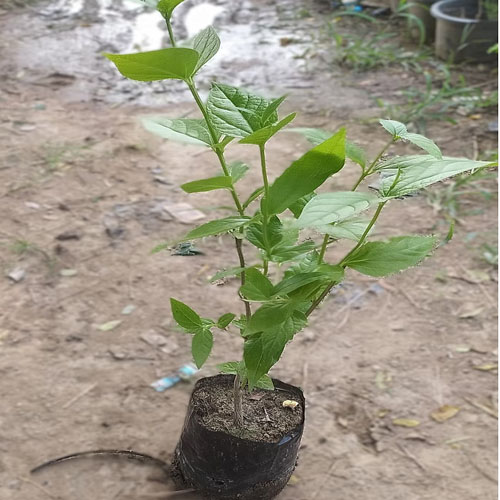Parijat ( Har Singar ) Plant
The Parijat plant, also known as Har Singar or Night-flowering Jasmine (scientific name: Nyctanthes arbor-tristis), is a small tropical tree or shrub celebrated for its aromatic, night-blooming flowers. It is valued for its ornamental beauty, medicinal properties, and cultural significance.
Appearance
- Size and Structure: Parijat is typically a small to medium-sized tree or shrub, growing 4-8 meters (13-26 feet) tall. It has a bushy, spreading form with a dense canopy.
- Leaves: The leaves are simple, ovate to elliptical, and dark green with a smooth texture. They are arranged alternately along the branches and have a distinctive pointed tip.
- Flowers: The flowers are white with a bright orange or yellow center, tubular in shape, and highly fragrant. They bloom in clusters during the night and drop off by morning. The tree's night-blooming nature gives it its common name.
- Fruit: The fruit is a small, green capsule that turns brown when mature. It contains seeds that are not commonly used in everyday applications.
Habitat
- Native Range: Parijat is native to tropical and subtropical regions of South and Southeast Asia, including India, Nepal, Bangladesh, Sri Lanka, and parts of Malaysia.
- Growing Conditions: The plant thrives in well-drained soil and full sun but can tolerate partial shade. It is suited to tropical and subtropical climates and can handle periods of drought once established.
Ecological Benefits
- Pollinator Attraction: The fragrant flowers attract nocturnal pollinators like moths and other insects, contributing to the local ecosystem's biodiversity.
- Aesthetic Value: Its fragrant, night-blooming flowers and lush foliage make it a popular choice for ornamental gardening in suitable climates.
Uses
- Medicinal Uses: Various parts of the Parijat plant, including the leaves, flowers, and seeds, are used in traditional medicine. It is believed to have anti-inflammatory, analgesic, and antipyretic properties. It is used to treat ailments such as fever, coughs, and skin conditions.
- Culinary Uses: The flowers are sometimes used in traditional culinary preparations and teas for their aromatic qualities, although this is not widespread.
- Ornamental: Parijat is valued for its beauty and fragrance. It is commonly planted in gardens, parks, and public spaces as an ornamental plant. It can be grown in containers or used as a hedge in tropical and subtropical regions.
Care and Maintenance
- Watering: Parijat requires regular watering during its initial growth phase but is relatively drought-tolerant once established. Consistent moisture is ideal for optimal growth.
- Pruning: Pruning helps maintain the plant's shape and encourages more blooms. Regular pruning is done to remove dead or damaged branches and to manage the plant's size.
- Fertilization: A balanced fertilizer applied during the growing season supports healthy growth and flowering. Parijat is generally low-maintenance but benefits from occasional feeding.
Cultural Significance
- Traditional Beliefs: In Indian culture, Parijat is considered sacred and is associated with various myths and legends. It is often planted near temples and homes and is linked to purity and divine beauty. The plant is also associated with the Hindu deities Krishna and Radha.
If you need more specific information about the Parijat (Har Singar) plant or have additional questions, feel free to ask!


